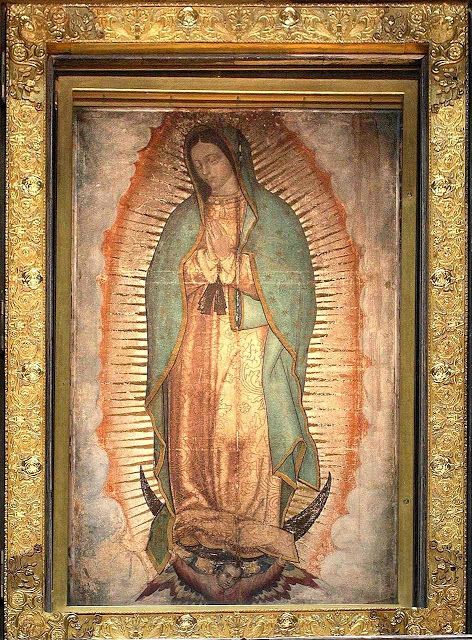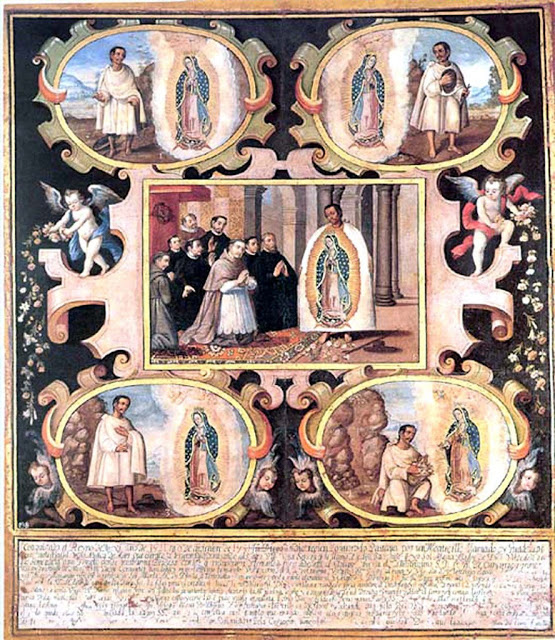Our Lady of Guadalupe appeared on 9th December 1531 to St. Juan Diego (1474–1548, canonized in 2002 by Pope John Paul II) on Tepyac Hill. The Blessed Virgin spoke in his native tongue, Náhuatl. The Indian was 57 years old and had been baptized. The third and last apparition took place on 12th December of the same year. As a proof of Her appearance, Our Lady left Her image miraculously impressed on St. Juan Diego’s tilma.
In the book written by Edésia Aducci, Mary and Her Glorious Titles, one can read the dialogue between Our Lady and Juan Diego:
During the first apparition, Our Lady, speaking in the Mexican language, said, “Listen, you whom I tenderly love as a small and delicate son, where are you going?” He answered, “My noble Lady, I am on my way to your house at Mexico-Tlatilulco; I will attend Holy Mass celebrated by the minister of God and your subject.”
Our Lady: “Know, my dear son, that I am the ever Virgin Mary, Mother of the true God, and it is my desire that they erect a temple to me in this place from where, as a loving Mother of you and your people, I will show my loving clemency and compassion that I have for the natives and those that love and seek me. I will hear their prayers and supplications to give them consolation and relief. And so that my will be done, you should go to Mexico City to the bishop’s palace and you will tell him that I sent you and that it is my will that he build a temple in this place. You will tell him what you saw and heard. I will thank you for this you do for me and I will give you prestige and exalt you.”
Juan Diego: “I will go immediately, most noble Lady of mine, to execute your commands as you humble servant.”
Second Apparition: Juan Diego returns from the bishop’s palace that afternoon. The Most Holy Virgin was waiting for him. “My very dear Queen and noble Lady, I did what you requested and, even though it was a long time before I could speak to my lord bishop, I communicated to him your message as you commanded. He heard me amiably and attentively, but his manner and questions led me to understand that he did not believe me. Therefore I ask you to give this charge to another … more worthy of respect who will be believed, because you know, my Lady, … that this is not something for me to do. Forgive me, my Queen, my boldness if I in any way lacked respect to your grandeur; may I not deserve your indignation, nor may my answer have displeased you.”
The Most Holy Virgin insists with Juan Diego. He then returns to the bishop and the prelate demands a sign of the apparition. The Indian returns and Our Lady tells him to return the next to this same place, at which time She will satisfy the wish of the bishop. But Juan Diego, having the need to call a priest for his uncle who had fallen ill, deviates from the accustomed route, certain that the Most Holy Virgin would not see him. But behold, Our Lady appears to him in another place.
“Where are you going, my son, and why did you take this way?”
Juan Diego: “My very beloved Lady, may God keep you! How are you this morning? How is your health?... Do not be irritated with what I will tell you: Your servant, my uncle, is sick and I am going quickly to the church of Tlatltelolco to get a priest to hear his confession and anoint him. After doing this task, I will return to this place to obey your command. Forgive me, my Lady, be patient with me and I will return tomorrow without fail.”
Our Lady: “Listen, my son, to what I will tell you: Do not be afflicted about anything, not even with illness or any other harmful things. Am I not here, am I not your Mother? Are you not under my protection and care? Am I not life and health? Are you not in my lap and walk under my care? Do you need anything else? . . . Worry no longer about your uncle’s health, as he will not die now, and have the certainty that he has been cured.”
One could make several commentaries on this event. One of the more interesting commentaries is that which has not been emphasized: Juan Diego’s attitude towards Our Lady and the language he uses to address Her.
I mention this because the other aspects—that is, how Our Lady likes to appear to the humble and simple people to send messages to the great, how She seeks pure souls to be Her spokesmen—have been dealt with in so many apparitions that I believe there is no special purpose to insist upon it tonight.
However, the language and attitude of the Our Lady towards the Indian is extraordinarily beautiful. She treats him like the son of a nation that is decadent and about to disappear, but who has a pure and simple soul. So, She treats him with extraordinary tenderness, almost as if he were a child. On the one hand, we see the predilection that Our Lady not only has for great and heroic souls that perform historic deeds, but, on the other hand, how She loves all forms of beauty, all forms of virtue. She also loves simple, small souls who are entirely turned to Her and even are unaware of their own virtue. She speaks to these souls with a unique tenderness.
Then we have the attitude of Juan Diego towards Our Lady. He speaks to Her as a courtesan greeting Our Lady, asking how She is doing, if She is well. After having told of the failure of his mission, he acts like a true diplomat and explains to Her the human reason for his failure. At the same time, he manifests his desire not to boast and put himself in the centre. You see how many qualities of soul are manifest here.
As a result, Our Lady appreciates his attitude, smiles upon his diplomatic suggestion, but does not accept it. On the contrary, She demands that he return. Juan Diego, always obedient, returns because he is not lazy and does not resist Her. He is the son of obedience. This was an order. Our Lady really wants it, so he returns once again!...
Our Lady reproduced Her image on Juan Diego’s tilma and he died in the odor of sanctity.
Here is a principle I wish to emphasize: Wherever there is virtue, there is also tact, courtesy, noble manners. Contrariwise, where virtue is dead, noble manners, tact, and courtesy gradually disappear.
Through baptism Juan Diego had a great delicateness of soul and thus was tactful in his manners and knew how to treat Our Lady with respect, with true nobility. On the contrary, if he had not had this delicateness of soul, he could even have been noble, but would not have treated Our Lady with true nobility.
This proves that Western Christian civilization developed good manners, nobility of treatment, gentlemanliness, gallantry, and aristocratic tone to a degree no other civilization had ever attained. This was because there had been a Middle Ages where these things were born and continued to develop even after the end of this period. There was an era of intense virtue, intense piety, during which souls yearned for nobility of treatment, delicateness, and grandeur. Since customs are born from intense desires of good and even bad souls, Western courtesy is the fruit of Christian piety and virtue.
When the revolutionary process began with the Renaissance, Europe’s spiritual life was tarnished with egalitarian principles. As a result decadence began. Why? Because from this point of view, revolution, egalitarianism, lack of delicate sentiments and nobility are entirely correlated. The egalitarian person cannot have nobility of manners, cannot be delicate in his sentiments, but rather is egotistical, brutal, tends towards the masses, does not want to acknowledge another’s merits and qualities. He would prefer to subject the whole social life and human relations, in a word, deal with every soul in a hard, cold, and crude egalitarian manner.
This is the extreme opposite of that delicateness that germinated in the virginal, supernatural, and so delicate soul of our good Juan Diego.
Here we can see the extent to which courtesy and aristocratic tone are daughters of the Holy, Roman, Catholic and Apostolic Church, and how the contrary—that which is vulgar, brutal and egalitarian manners—is precisely the fruit of the Revolution and the devil.
Here you have a commentary on the manners and soul of good Juan Diego. Our Lady of Guadalupe, pray for us!
From:
http://www.pliniocorreadeoliveira.info/UK_661212_OurLady_of_Guadalupe.htm#.U4uJbUZOXYw



No comments:
Post a Comment